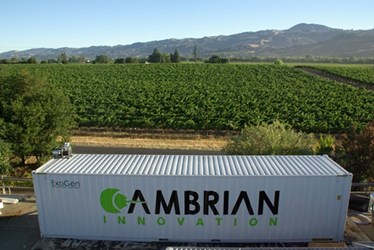Electricity-Producing Microbes Treat Wastewater, Provide Power Source

By Laura Martin

Newly discovered electrogenic organisms could significantly reduce energy costs for the wastewater industry.
These microscopic living organisms can convert chemical energy to electrical energy. They extract energy by breaking down waste chemicals and then sending the energy from those chemicals to electrodes that shuttle them off as electrical current.
Boston-based company Cambrian Innovation is capitalizing on these organisms with the EcoVolt Bioelectric Wastewater Treatment System, which launched in October. The system is the first and only industrial-scale bioelectrically enhanced wastewater treatment system currently on the market.
The EcoVolt uses electrogenic organisms to both remove 80 to 90 percent of pollutants from wastewater and generate methane fuel that can be used on-site for clean power and heat production.
“These microbes generate electricity at a very high rate,” says Matt Silver, Cambrian's CEO and co-founder. “We are very excited to be the first to bring this to the market.”
EcoVolt Bioelectric Treatment System from Cambrian Innovation on Vimeo.
The system is applicable to a variety of sectors that deal with wastewater treatment, but Cambrian is currently marketing the EcoVolt to the food and beverage industry. This is due to the high level of biochemical oxygen demand (BOD) in the wastewater streams at food and beverage facilities.
“We can treat BOD concentrations that are below what the average system is able to treat,” Silver says.
Wineries and breweries are in need of energy-efficient water treatment equipment. On average, a winery uses five to seven gallons of water to produce one gallon of wine. A brewery uses an estimated six gallons of water to produce one gallon of beer. Dealing with this much wastewater requires a large amount of energy.
Drinking water and wastewater systems account for approximately 3 to 4 percent of energy use in the United States, resulting in emissions of more than 45 million tons of greenhouse gases annually, according to the EPA. Although the EcoVolt system does require some energy to get started, the energy it creates allows facilities to save money, decrease grid reliance, and move toward a sustainable water management plan.
“When you think about competing water treatment methods, their electricity consumption is massive,” says Silver. “This is a water treatment system that has a positive energy effect.”
The EcoVolt has other benefits as well. The system is designed so the operators can focus on day-to-day business operations instead of wastewater management.
“A lot of it is automated,” says Silver. “It is less operator-intensive. We can remotely monitor the actual health of the reactor, so the customer doesn’t have to worry about it.”
The system can be customized to treat anywhere from 10,000 to 400,000 or more gallons a day and adjusted as a business grows. “It is also easily transportable, so food and beverage suppliers that are looking to produce at a variety of sites have the option of moving the system with them,” says Silver.
Cambrian officials have estimated the system can save a food and beverage production facility anywhere from $100,000 to over $1 million a year. The company is already making plans to expand its bioelectrical technology to other markets. They received funding from NASA to research water and air recycling for space applications.
“We are getting a lot of interest,” says Silver. “There are a lot of applications out there for this technology.”
Could this new technology help your business? Tell us what you think in the comments section below.
